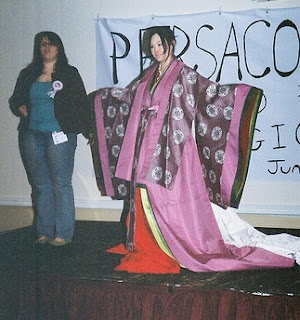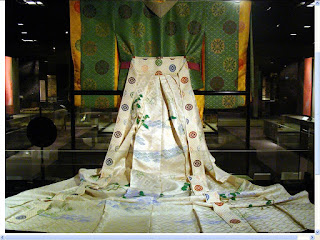It happens every once in a while. I started on a Heian court ensemble quite some time ago (right about this time last year, if memory and my nagabakama tutorial serve me), but I never really continued on it. Let's face it...Heian garb, especially formal court garb, is insanely intimidating. There are so many layers, with so many names to remember, all of them very similar, yet just slightly different from each other. And woe to the lady who wears her layers in an unfashionable colour arrangement!
Fear not, fellow Heian costumers! After some research, I've compiled the information on layers, their lengths, and some information on colour combinations. Here's a breakdown of a court ensemble.
Layer 1: Kosode & Nagabakama
Kosode is the forerunner to the modern kimono, and literally means "small sleeves". They were worn by both men and women in the period. Kosode, as far as I have found, were always white.
Wodeford Hall has long been a great resource for period Japanese garb. She tends to focus on a later period, but the kosode was pretty much unchanged for most of its existence, so it's still a good place to start.
This is one of my favourite kosode tutorials, which gives not only the layout and yardage needed, but tips on fabrics and what types of silks you can get that are period, but not outrageously expensive.
I'll have my own kosode tutorial up eventually, I just need to find the time to go and make my own so I can give you a visual step-by-step of the process.
Wodeford Hall's Kosode dimensions:
Sleeve (2 each): 16.5" x 30".
Body panel (2 each) 16.5" x (2 x length from nape of neck to knees - this is being worn under nagabakama).
Okumi - overlap panels (2 each) 8" x 44."
Collar (1) 8" x 54"
Nagabakama are pleated trousers worn for formal court appearances. They are exactly like regular hakama, except that the pant legs are much longer, and would be tread on while walking. (Nagabakama are pretty much thought of as exclusively belong to women's dress, but there are several examples of men wearing them, as well. They appear to be courtiers or body guards, and you can see some of the examples in these paintings. It should be noted, however, that those examples seem to be from the Edo period, which is much later than Heian.)
Nagabakama were very formal. For more informal occasions, ladies would wear regular hakama, which were floor length. As far as I've been able to find, nagabakama and hakama were always red, though I did find one person saying that a photo studio in Japan that specializes in Heian era photo sessions said that married women wore red, and unmarried women wore purple, but I haven't been able to find any extant examples or documentation to support that.
My nagabakama/hakama tutorial is here.
Layer 2: Hitoe
Wodeford Hall's Hitoe Dimensions:
Sleeves (2 each) 18" x 60"
Body panels (2 each) 18" x 165" (which should be amply long and trailing enough for most women!)
Okumi (2 each) 9" x 75"
Collar (1 each) 9" x 81.5"
Layers 3+: Uchigi/Kinu
The uchigi or kinu are where the Heian era's clothing gets its name, juni-hitoe, which means "twelve layered robes." (Hitoe translates directly to "unlined robe", though the uchigi were usually lined robes.) It's a bit of a misnomer, because at the beginning of the period, there was no restriction on the number of robes someone could wear, and there could be as many as 40 layers! However, in 1074 AD, a sumptuary law was passed that limited the number of robes to 5.
These robes were lined in complementary colours. The lining would peek out ever so slightly, maybe 1/8-1/4", at the neckline and on the sleeves.
Again, these are cut with the same layout and general pieces as the other layers, just with different dimensions.
Wodeford Hall's Uchigi or ginu (layers worn over the hitoe) dimensions:
Sleeves (2 each) 18" x 62"
Body panels (2 each) 18" x 150" (which should be amply long and trailing enough for most women!)
Okumi (2 each) 9" x 67"
Collar (1) 9" x 75"
Sleeves (2 each) 18" x 62"
Body panels (2 each) 18" x 150" (which should be amply long and trailing enough for most women!)
Okumi (2 each) 9" x 67"
Collar (1) 9" x 75"
All of the uchigi layers had the same sleeve length. You might be tempted to make them at different lengths so you can see each colour, but the peeking of each colour was achieved through careful dressing, not through the construction of the garment itself.
Layer : Uchiginu
Over the uchigi, one would usually wear a uchiginu, which would provide stiffening for the upper garments, and hold them out to add volume. This layer was made of beaten, stiffened silk, and was barely visible when worn. The uchiginu had the same dimensions as the upper layers, which we'll look at next.
Uwagi & Uchiginu (layer worn on top of uchigi):
Sleeves (2 each) 16" x 66"
Body panels (2 each) 16" x 144" (which should be amply long and trailing enough for most women!)
Okumi (2 each) 8" x 64"
Collar (1 each) 8" x 75"
Layer : Uchiginu
Over the uchigi, one would usually wear a uchiginu, which would provide stiffening for the upper garments, and hold them out to add volume. This layer was made of beaten, stiffened silk, and was barely visible when worn. The uchiginu had the same dimensions as the upper layers, which we'll look at next.
Uwagi & Uchiginu (layer worn on top of uchigi):
Sleeves (2 each) 16" x 66"
Body panels (2 each) 16" x 144" (which should be amply long and trailing enough for most women!)
Okumi (2 each) 8" x 64"
Collar (1 each) 8" x 75"
Top Layer: Uwagi
The top layer was the uwagi. This layer, depending on your rank, could be patterned, painted, made of brocade, etc. Since it was the top layer, it was usually the flashiest of the layers. The uchigi were usually pretty plain in comparison since they wouldn't be seen, unless you had enough wealth to have them patterned.
Uwagi (layer worn on top of uchigi):
Sleeves (2 each) 16" x 66"
Body panels (2 each) 16" x 144" (which should be amply long and trailing enough for most women!)
Okumi (2 each) 8" x 64"
Collar (1 each) 8" x 75"
Sleeves (2 each) 16" x 66"
Body panels (2 each) 16" x 144" (which should be amply long and trailing enough for most women!)
Okumi (2 each) 8" x 64"
Collar (1 each) 8" x 75"
For informal situations, your ensemble usually ended with the uwagi. For the most formal situations, and for court appearances, you would wear the final layer...
Final Layer: Karaginu-mo
Karaginu-mo are actually two different garments, though they are always worn together. The karaginu (not to be confused with kariginu, which is a Heian-era men's garment, or kataginu, which is a men's garment from a much later period) is a short overcoat, which I've seen described as "tuxedo tails for Japanese court costume". "Karaginu" means "chinese coat", and is a remnant from an earlier period when Chinese fashions were in style. The karaginu is shorter in the back than in the front, and has a wide collar, which is attached directly to the body of the garment, without there being front extensions like on the other layers. The sleeves were slightly shorter than on the other layers, as well, to show off the fabric of the uwagi. The collar in the back appears triangular, and lays flat, instead of being round and curving around the neck the way the collars on other layers do.
The mo was worn in the back, and has been described as a backward apron. It trailed along behind the wearer, and was usually white or a light colour, though there are some modern reproductions that have coloured mo. (Not sure how historically accurate that is, though.) There were streamers on either side of the mo that would trail down behind the wearer as she walked.
The patterns on the mo was usually evocative of nature, and might have been painted on, embroidered, or applied in metal foil. This exert from The Diary of Lady Murasaki describes some of the mo and karaginu worn by ladies of the court on the fifth day following the birth of an Imperial Prince:
"When they had
finished serving, the women went to sit down by the blinds. Everything
was sparkling in the light of the flares but, even so, some women stood
out: Lady Oshikibu wore a beautiful
train [mo] and jacket [karaginu], both embroidered with the Komatsubara
scene at Mount Oshio. She is the wife of the Governor of Michinokuni and
His Excellency's envoy, you know. Lady Tayu had left her jacket as it
was, but her train had a striking wave pattern printed on it in silver,
not overly conspicuous but most pleasing to the eye. Ben no Naishi had a
train printed with an unusual design, a crane standing in a silver
seascape; as a symbol of longevity it was a perfect complement to the
pine branches on the embroidery. Lady Shosho's train was decorated with
silver foil that was not quite up to the same standard as the others,
and it became the subject of some adverse comment."
(The Diary of Lady Murasaki, translated by Richard Bowring, New York, Penguin 1996, p. 17-18.)
I'm not quite sure what the pattern for the mo might look like, but I'm working on trying to figure it out. I think it might be similar to hakama, looking at how the pleats are done, but I still need to do more research on it, because I really don't want to have to buy one of the super expensive period-correct patterns for karaginu-mo.
I was going to get into colour combinations, but this post is already long enough as it is, so I'll leave that for next time. I'll finally have time to work on my own projects again in the very near future, so I plan to pick my juni-hitoe back up again, and get back to work on all my layers. (I'm going to start with 8, and see how I feel about adding more.) I'll be adding tutorials as I go, so look for those sometime early next year!
For lots and lots of examples of juni-hitoe and Heian era fashion, check out my Pinterest board - Heian Era Court Garb.




































No comments:
Post a Comment